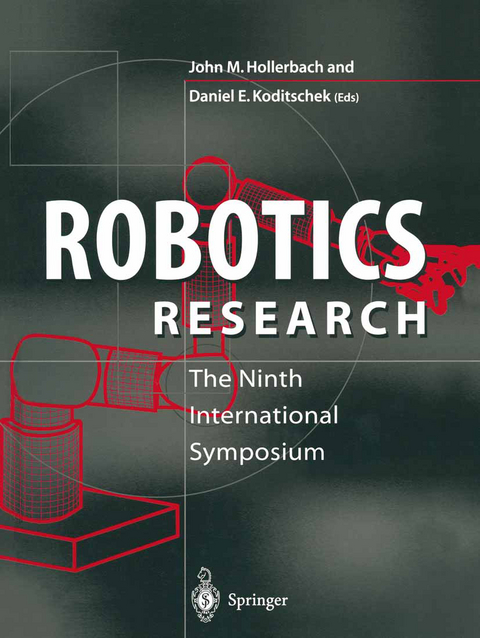
Robotics Research
Springer London Ltd (Verlag)
978-1-4471-1254-9 (ISBN)
A board of eighteen officers was appointed: Suguru Arimoto (Tokyo University) Ruzena Bajcsy (University of Pennsylvania) Robert Bolles (SRI International) Mike Brady (Oxford University) Paolo Dario (Pisa University, Italy) Joris De Schutter (Katholieke Universiteit Leuven, Belgium) Olivier Faugeras (INRIA, France) Georges Giralt (LAAS-CNRS, Fra~ce), Secretary Gerd Hirzinger (DFVLR, Germany) Hirochika Inoue (Tokyo University), President-elect Ray Jarvis (Monash University, Australia) Takeo Kanade (Carnegie Mellon University) Hirofumi Miura (Tokyo University) Richard Paul (University of Pennsylvania), President Marc Raibert (Massachusetts Institute of Technology) Bernie Roth (Stanford University) Yoshiaki Shirai (Osaka University) Tsuneo Yoshikawa (Kyoto University) It was our commitment to bring together active, leading robotics researchers from academia, government, and industry, with the ambitious objective to assess the state of Advanced Robotics and to discuss future research directions. Papers representing authoritative reviews of established research areas as well as papers reporting on new areas were sought for presentation.
A number ofleading researchers were asked to submit extended abstracts outlining papers representing their areas of research. In addition to inviting participants, a call for papers was issued in order to include researchers who had made significant new contributions to robotics.
Preface.- List of Authors.- 1. Manipulation.- Session Summary.- Hands for Dexterous Manipulation and Powerful Grasping: A Difficult Road Towards Simplicity.- An Exploration of Nonprehensile Two-Palm Manipulation : Planning and Execution.- Control of Physical Contact and Dynamic Interaction.- Reorienting Objects with a Robot Hand Using Grasp Gaits.- 2.Control.- Session Summary.- Another Language for Describing Robot Motions: A Nonlinear Position-dependent Circuit Theory.- Nonlinear Behavior and Control of Underactuated Robotic Mechanisms.- Parallel Force/Position Control of Robot Manipulators.- Modeling, Controllability and Vibration Suppression of 3D Flexible Robots.- Moving Base Robotics and Reaction Management Control.- 3. Robot Assistance for Surgery and Personal Care.- Session Summary.- Robotic Aids for Laparoscopic Surgery Problems.- Design of Customized Rehabilitation Aids.- 4. Tight Coupling of Perception with Action.- Session Summary.- Perception-Action Network for Sensor Fusion and Planning.- Toward A Systems Theory for the Composition of Dynamically Dexterous Robot Behaviors.- Research Program on Mechanisms for Emergent Machine Intelligence.- 5. Telerobotics and Virtual Reality.- Session Summary.- Force Replication to the Human Operator: The Development of Arm and Hand Exoskeletons as Haptic Interfaces.- Intelligent Tele-Robotics.- Performance Measures for Haptic Interfaces.- Operator Control of Robotic Systems.- Haptic Virtual Reality: Display of Operating Feel of Dynamic Virtual Objects.- 6. Motion Planning and Task-Level Programming.- Session Summary.- Formal Verification in Robotics: Why and How?.- Robot Motion Planning in Dynamic Environments.- A Random Sampling Scheme for Path Planning.- Planar Manipulation on a Conveyor with a One Joint Robot.- 7. Learning and Skill Acquisition.- Session Summary.- Behavior Acquisition via Vision-Based Robot Learning.- Perception and Manipulation in Robotics: Neural Network Approaches.- Integration of Symbolic and Subsymbolic Learning to Support Robot Programming by Human Demonstration.- Designing Skills with Visual Feedback for APO.- 8. Multi-Robot Interacting Systems.- Session Summary.- A Multi-Robot Cooperation Scheme Based on Incremental Plan-Merging.- Force Strategies for Cooperative Tasks in Multiple Mobile Manipulation Systems.- Behavior Matching by Observation for Multi-Robot Cooperation.- 9.3D Vision.- 3D Vision - Shape and Colour.- A Multi-body Factorization Method for Motion Analysis.- Focus Range Sensors.- Is Structure-From-Motion Worth Pursuing?.- 10. Active/Real-Time Vision.- Session Summary.- Visual Guidance of an AGV.- Active Vision and Seeing Robots.- Automatic Task Planning for Robot Vision.- Object Tracking by Using Optical Flows and Edges.- 11. How Do We Build Reliable and Efective Mobile Robots?.- Session Summary.- Adaptive Navigation for Autonomous Mobile Robots.- Parallel Use of Differential and Integral Representation for Realising Efficient Mobile Robots.- Robust Autonoraous Low-Cost Mobility.- Obstacle Detection for Unmanned Ground Vehicles: A Progress Report.- 12. Visual Servoing.- Session Summary.- Dynamic Issues in Robot Visual-Servo Systems.- Extended Vision with the Robot Sensor Suit: A Primary Sensor Image Approach to Interfacing Body to Brain.- 13. Symbolic Geometry and Effective Algebra for Robotics and Vision.- Session Summary.- Symbolic Geometry and Effective Algebra for Solving Problems in Computer Vision: Where do we Stand, Where may we Go.- Sine-Cosine Polynomial Systems.- 14. Mechanisms and Design.- Session Summary.- Geometrie Perspectives on the Mechanics and Control of Robotic Locomotion.- Design of Hyper-Redundant Arm.- The Calibration Index and the Role of Input Noise in Robot Calibration.- 15. Microrobotics.- Session Summary.- A Planar Milli-Robot System on an Air Bearing.- Sub-Micron Large Motion Multi-Robot Planar Motion System or ROBOTWORLD - The Next Generation.- Intelligent Manipulation Robot in Micro and Nano meter World.- Hybrid Robots Consisting of Mechanical Parts and Living Organisms for Microrobot Application.- 16. Industrial Systems Issues.- Session Summary.- Localization of Autonomous Guided Vehicles.- Hardware Design Methods and Proposals for Open System Architecture of Intelligent Robots.- Robots, Transportation, and Society.- Participants.
| Zusatzinfo | XI, 460 p. |
|---|---|
| Verlagsort | England |
| Sprache | englisch |
| Maße | 210 x 279 mm |
| Gewicht | 1363 g |
| Themenwelt | Informatik ► Theorie / Studium ► Künstliche Intelligenz / Robotik |
| Technik ► Elektrotechnik / Energietechnik | |
| Technik ► Maschinenbau | |
| Schlagworte | International Symposium of Robotics Research • ISRR • Robotics |
| ISBN-10 | 1-4471-1254-7 / 1447112547 |
| ISBN-13 | 978-1-4471-1254-9 / 9781447112549 |
| Zustand | Neuware |
| Haben Sie eine Frage zum Produkt? |
aus dem Bereich


